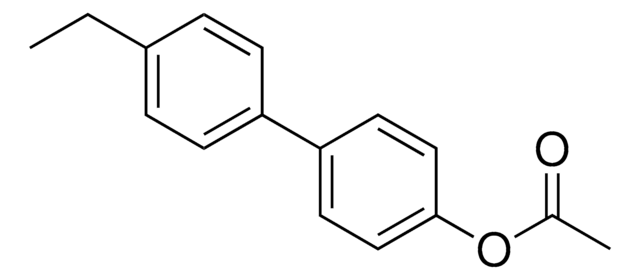B56501
4-Bromoanisole
≥99.0%
Synonym(s):
1-Bromo-4-methoxybenzene
Sign Into View Organizational & Contract Pricing
All Photos(1)
About This Item
Linear Formula:
BrC6H4OCH3
CAS Number:
Molecular Weight:
187.03
Beilstein:
1237590
EC Number:
MDL number:
UNSPSC Code:
12352100
PubChem Substance ID:
NACRES:
NA.22
Recommended Products
Assay
≥99.0%
form
liquid
refractive index
n20/D 1.564 (lit.)
bp
223 °C (lit.)
mp
9-10 °C (lit.)
density
1.494 g/mL at 25 °C (lit.)
SMILES string
COc1ccc(Br)cc1
InChI
1S/C7H7BrO/c1-9-7-4-2-6(8)3-5-7/h2-5H,1H3
InChI key
QJPJQTDYNZXKQF-UHFFFAOYSA-N
Looking for similar products? Visit Product Comparison Guide
Related Categories
General description
4-Bromoanisole is a useful brominating reagent. It is formed as reaction product in the reaction between HOBr and anisole. Suzuki coupling of 4-bromoanisole with phenylboronic acid catalyzed by palladium pincer complexes has been studied. Heck Reaction of 4-bromoanisole with ethyl acrylates in room-temperature ionic liquids is reported to afford ethyl 4-methoxycinnamate.
Application
4-Bromoanisole was used in the synthesis of aryl 1,3-diketones.
Signal Word
Warning
Hazard Statements
Precautionary Statements
Hazard Classifications
Acute Tox. 4 Oral - Skin Irrit. 2
Storage Class Code
10 - Combustible liquids
WGK
WGK 2
Flash Point(F)
201.2 °F
Flash Point(C)
94 °C
Personal Protective Equipment
dust mask type N95 (US), Eyeshields, Gloves
Choose from one of the most recent versions:
Already Own This Product?
Find documentation for the products that you have recently purchased in the Document Library.
Customers Also Viewed
Amy E Bryant et al.
PloS one, 12(2), e0172486-e0172486 (2017-03-01)
Acute muscle injuries are exceedingly common and non-steroidal anti-inflammatory drugs (NSAIDs) are widely consumed to reduce the associated inflammation, swelling and pain that peak 1-2 days post-injury. While prophylactic use or early administration of NSAIDs has been shown to delay
Palladium bis (phosphinite)'PCP'-pincer complexes and their application as catalysts in the Suzuki reaction.
Bedford RB, et al.
New. J. Chem., 24(10), 745-747 (2000)
Dennis U Nielsen et al.
Chemistry (Weinheim an der Bergstrasse, Germany), 19(52), 17926-17938 (2013-11-23)
Reaction conditions for the three-component synthesis of aryl 1,3-diketones are reported applying the palladium-catalyzed carbonylative α-arylation of ketones with aryl bromides. The optimal conditions were found by using a catalytic system derived from [Pd(dba)2] (dba=dibenzylideneacetone) as the palladium source and
Liping Sun et al.
Journal of separation science, 41(19), 3716-3723 (2018-08-15)
After being coupled, florisil was modified with four kinds of aliphatic or aromatic groups and were applied to the determination of rutin in orange peel sample by a pipette-tip solid-phase extraction method. The materials were characterized by scanning electron microscopy
Valdecir Farias Ximenes et al.
Journal of inorganic biochemistry, 146, 61-68 (2015-03-17)
Hypobromous acid (HOBr) is an inorganic acid produced by the oxidation of the bromide anion (Br(-)). The blood plasma level of Br(-) is more than 1,000-fold lower than that of chloride anion (Cl(-)). Consequently, the endogenous production of HOBr is
Our team of scientists has experience in all areas of research including Life Science, Material Science, Chemical Synthesis, Chromatography, Analytical and many others.
Contact Technical Service












